- We have learned that when current flows in a conductor, a magnetic field will be generated.
- When the current-carrying conductor is placed in a magnetic field, the interaction between the two magnetic fields will produce a resultant field known as the catapult field as shown in the figure below.
- The catapult field is a non-uniform field where the field at one side is stronger than the other side.
- As a result, a force is produced to move the current-carrying conductor from the stronger field to the weaker field.
- The force produced by a catapult field is called the catapult force.
- The direction of the force can be determined by Fleming’s left-hand rule as shown in Figure below.
- The forefinger, middle finger and the thumb are perpendicular to each other. The forefinger points along the direction of the magnetic field, middle finger points in the current direction and the thumb points along the direction of the force.
- The strength of the force can be increased by:
- Increase the current
- Using a stronger magnet
- using a longer wire
- arranging the wire perpendicular to the direction of the magnetic field.
Recommended Videos
Force on a current-carrying conductor in a magnetic field – Physics























